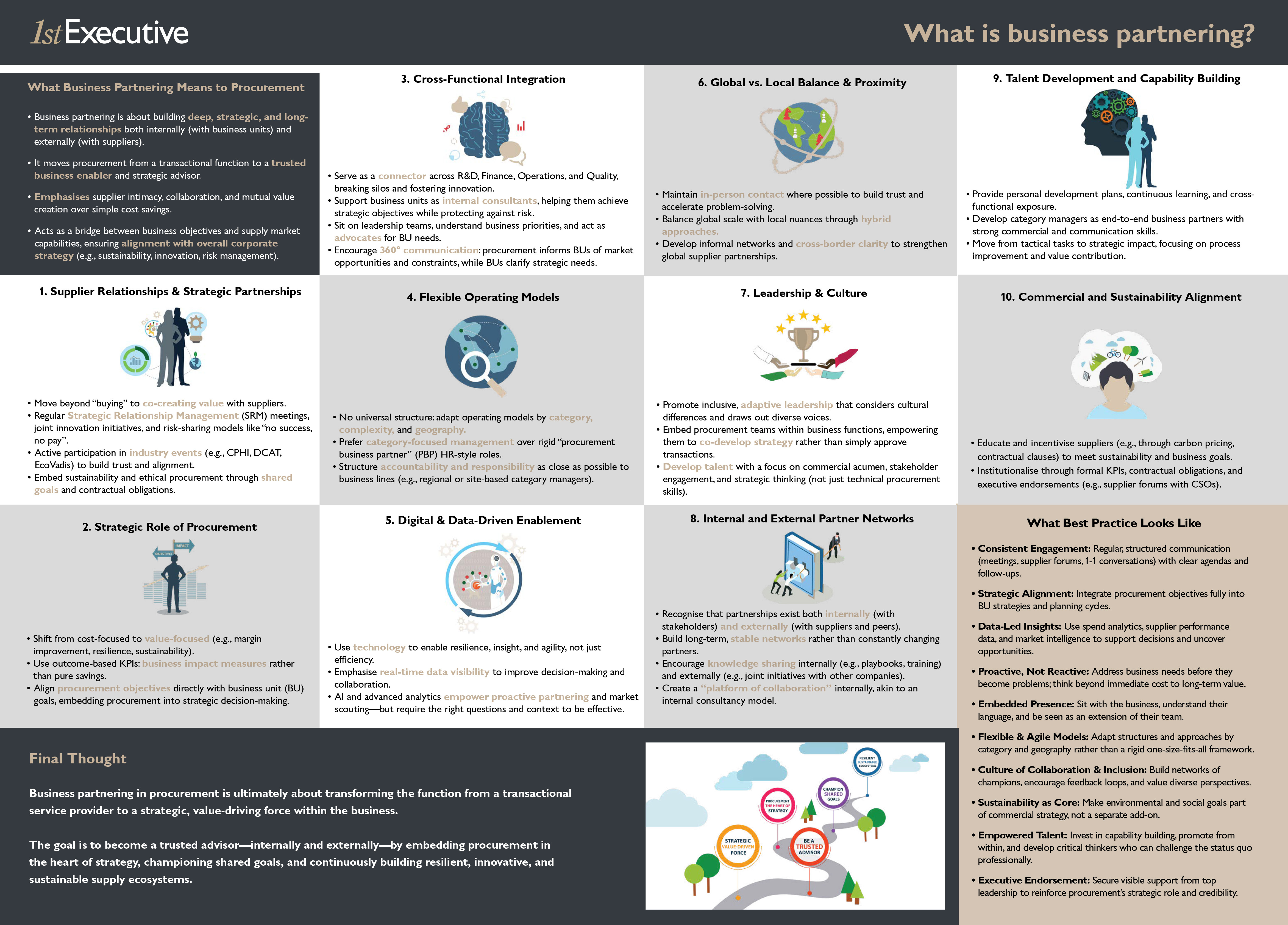September 2025 - "Business Partnering"; What is it?

Richard Shelley
September 2025 - What is business partnering?
Procurement have been saying they need to 'do it better' for the past 10 years but does anyone have a winning formula?' In the latest of 1st Executive’s CPO Insight series we posed this question to our network of global procurement leaders.
🔑 What Business Partnering Means to Procurement:
Business partnering is about building deep, strategic, and long-term relationships both internally (with business units) and externally (with suppliers).
It moves procurement from a transactional function to a trusted business enabler and strategic advisor.
Emphasises supplier intimacy, collaboration, and mutual value creation over simple cost savings.
Acts as a bridge between business objectives and supply market capabilities, ensuring alignment with overall corporate strategy (e.g., sustainability, innovation, risk management).
🌟 Strands of Business Partnering:
1️⃣ Supplier Relationships & Strategic Partnerships
Move beyond "buying" to co-creating value with suppliers.
Regular Strategic Relationship Management (SRM) meetings, joint innovation initiatives, and risk-sharing models like "no success, no pay".
Active participation in industry events (e.g., CPHI, DCAT, EcoVadis) to build trust and alignment.
Embed sustainability and ethical procurement through shared goals and contractual obligations.
2️⃣ Strategic Role of Procurement
Shift from cost-focused to value-focused (e.g., margin improvement, resilience, sustainability).
Use outcome-based KPIs: business impact measures rather than pure savings.
Align procurement objectives directly with business unit (BU) goals, embedding procurement into strategic decision-making.
3️⃣ Cross-Functional Integration
Serve as a connector across R&D, Finance, Operations, and Quality, breaking silos and fostering innovation.
Support business units as internal consultants, helping them achieve strategic objectives while protecting against risk.
Sit on leadership teams, understand business priorities, and act as advocates for BU needs.
Encourage 360° communication: procurement informs BUs of market opportunities and constraints, while BUs clarify strategic needs.
4️⃣ Flexible Operating Models
No universal structure: adapt operating models by category, complexity, and geography.
Prefer category-focused management over rigid "procurement business partner" (PBP) HR-style roles.
Structure accountability and responsibility as close as possible to business lines (e.g., regional or site-based category managers).
5️⃣ Digital & Data-Driven Enablement
Use technology to enable resilience, insight, and agility, not just efficiency.
Emphasise real-time data visibility to improve decision-making and collaboration.
AI and advanced analytics empower proactive partnering and market scouting—but require the right questions and context to be effective.
6️⃣ Global vs. Local Balance & Proximity
Maintain in-person contact where possible to build trust and accelerate problem-solving.
Balance global scale with local nuances through hybrid approaches.
Develop informal networks and cross-border clarity to strengthen global supplier partnerships.
7️⃣ Leadership & Culture
Promote inclusive, adaptive leadership that considers cultural differences and draws out diverse voices.
Embed procurement teams within business functions, empowering them to co-develop strategy rather than simply approve transactions.
Develop talent with a focus on commercial acumen, stakeholder engagement, and strategic thinking (not just technical procurement skills).
8️⃣ Internal and External Partner Networks
Recognise that partnerships exist both internally (with stakeholders) and externally (with suppliers and peers).
Build long-term, stable networks rather than constantly changing partners.
Encourage knowledge sharing internally (e.g., playbooks, training) and externally (e.g., joint initiatives with other companies).
Create a "platform of collaboration" internally, akin to an internal consultancy model.
9️⃣ Talent Development and Capability Building
Provide personal development plans, continuous learning, and cross-functional exposure.
Develop category managers as end-to-end business partners with strong commercial and communication skills.
Move from tactical tasks to strategic impact, focusing on process improvement and value contribution.
1️⃣0️⃣ Commercial and Sustainability Alignment
Educate and incentivise suppliers (e.g., through carbon pricing, contractual clauses) to meet sustainability and business goals.
Institutionalise through formal KPIs, contractual obligations, and executive endorsements (e.g., supplier forums with CSOs).
✅ What Best Practice Looks Like:
Consistent Engagement: Regular, structured communication (meetings, supplier forums, 1-1 conversations) with clear agendas and follow-ups.
Strategic Alignment: Integrate procurement objectives fully into BU strategies and planning cycles.
Data-Led Insights: Use spend analytics, supplier performance data, and market intelligence to support decisions and uncover opportunities.
Proactive, Not Reactive: Address business needs before they become problems; think beyond immediate cost to long-term value.
Embedded Presence: Sit with the business, understand their language, and be seen as an extension of their team.
Flexible & Agile Models: Adapt structures and approaches by category and geography rather than a rigid one-size-fits-all framework.
Culture of Collaboration & Inclusion: Build networks of champions, encourage feedback loops, and value diverse perspectives.
Sustainability as Core: Make environmental and social goals part of commercial strategy, not a separate add-on.
Empowered Talent: Invest in capability building, promote from within, and develop critical thinkers who can challenge the status quo professionally.
Executive Endorsement: Secure visible support from top leadership to reinforce procurement’s strategic role and credibility.
💬 Final Thought:
Business partnering in procurement is ultimately about transforming the function from a transactional service provider to a strategic, value-driving force within the business. The goal is to become a trusted advisor—internally and externally—by embedding procurement in the heart of strategy, championing shared goals, and continuously building resilient, innovative, and sustainable supply ecosystems.
